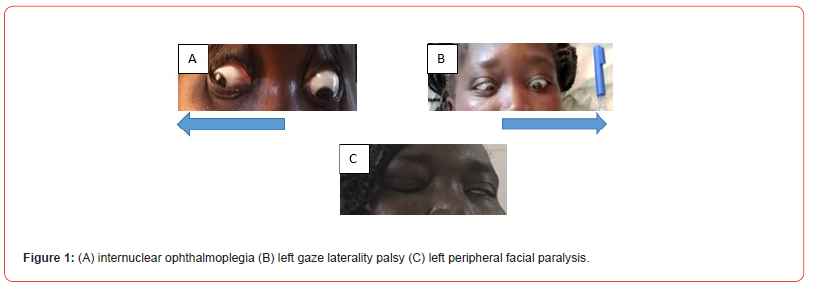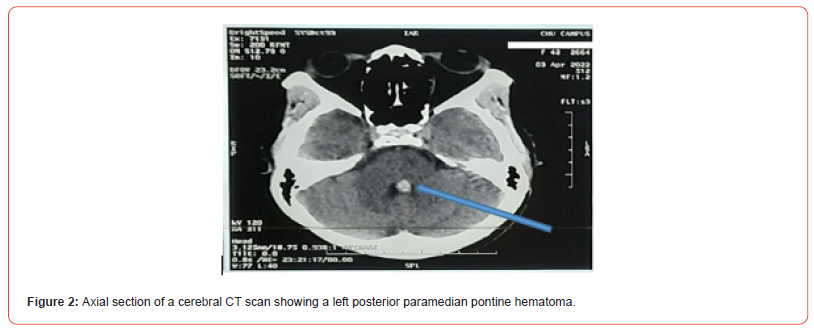 Case Report
Case Report
Fisher’s Eight-And-A-Half Syndrome Related to a Dorsomedial Pontine Hematoma at CHU Campus De Lomé (Togo)
Kossivi Apetse1*, Koumateh Marzouk Afoda2, Jonathan Pierre Denis Clément Njembe2, Venunye Fiawoo2,Assogba Komi3 and Agnon Ayelola Koffi Balogou4
1Service de Neurologie, CHR Atakpamé, Université de Lomé, Togo
2Service de neurologie, CHU Campus, Lomé, Togo
3Service de Neurologie, CHU Sylvanus Olympio, Université de Lomé, Togo
4Service de neurologie CHU Campus, Université de Lomé, Togo
Kossivi Apetse, Service de Neurologie, CHR Atakpamé, Université de Lomé, Togo.
Received Date:April 11, 2025; Published Date:April 30, 2025
The combination of internuclear ophthalmoplegia and gaze palsy characterizes Fisher’s one-and-a-half syndrome, an uncommon neurological clinical entity. This syndrome, associated with peripheral facial palsy, constitutes a rarer entity, Fisher’s eight-and-a-half syndrome. This is one of the syndromes eflecting brainstem involvement caused by unilateral lesions involving the tegmentum of the pont. The anatomical structures affected are the nucleus of cranial VI (the abducens), the median longitudinal fasciculus in the pontic reticular formation and the facial nerve. The common causes of this syndrome are multiple sclerosis, stroke and tumors. We report a case of a 42-year-old female patient presenting with Fisher’s eightand- a-half syndrome related to a dorsomedial pontine hematoma at CHU Campus de Lomé (Togo).
Background
Fisher’s eight-and-a-half syndrome is a rare clinical entity characterized by the association of one-and-a-half Fisher syndrome (internuclear ophthalmoplegia (INO), gaze laterality palsy) [1] and peripheral facial paralysis, PFP (11/2 + 7 = 81/2) [2]. The anatomical structures affected are the abducens nerve nucleus, the median longitudinal fasciculus (MLF) in the pontic reticular formation and the facial nerve. The common causes of this syndrome are multiple sclerosis [3, 4], stroke [5-8] and tumors [9, 10]. We report a case of a 42-year-old female patient presenting with Fisher’s eight-and-a-half syndrome related to a dorsomedial pontine hematoma at CHU Campus de Lomé (Togo).
Case Presentation
A 42-year-old, right-handed patient with a history of hypertension 10 years previously, poorly monitored, was admitted in april 2022 for the sudden onset of rotatory vertigo associated with rightward deviation of the mouth and visual blur evolving two days before admission. There was no history of headache, vomiting or eizure. Clinical examination revealed grade III hypertension, binocular diplopia, left PFP with a positive Charles Bell sign, right INO (paralysis of left eye adduction with preserved convergence, nystagmus of the right eye in abduction) and left gaze laterality paralysis (paralysis of left eye abduction and right eye adduction), resulting in Fisher’s eight-and-a-half syndrome (Figure 1).
The rest of the physical examination was unremarkable. A cerebral CT scan (Figure 2) performed on the third day of onset of the neurological deficit showed a spontaneous left paramedian posterior pontine hyperdensity approximately four millimeters in diameter, with no mass effect or ventricular effraction. Antihypertensive treatment and facial physiotherapy were instituted. The patient did not benefit from orthoptic rehabilitation. The evolution was favourable and the patient returned home after a week’s hospitalization with her blood pressure controlled at 130/80 mm Hg and the rest of the clinical picture unchanged. A sixmonth follow-up clinical examination showed BP at 140/100 mm Hg; normal oculomotor examination; complete regression of PFP; preservation of autonomy with a modified Rankin score of 0/6.


Discussion
Fisher’s eight-and-a-half syndrome is a fairly rare clinical entity with very few documented cases, first reported by Eggenberger et al [2] in 1998. Our patient presented with right OIN, left lateralis palsy and left PFP. The paralysis of laterality of gaze to the left was manifested by an abduction deficit in the left eye and an adduction paralysis in the right eye. It is due to nuclear damage to the left VIth cranial nucleus, which controls the homolateral lateral rectus and projects to the contralateral IIIrd cranial nucleus via the medial longitudinal bundle to activate the medial rectus. It may also be caused by a lesion of the horizontal gaze center (paramedian pontic reticular formation), which sends afferents to the VI cranial nucleus. Right OIN resulted in adduction paralysis of the right eye and nystagmus of the contralateral eye in abduction, linked to involvement of the left FLM.
Left peripheral facial palsy is a deficit in the function of the ipsilateral facial nerve, reflecting damage to the nerve fibers downstream of the left VIIth nucleus in the facial colliculus, which surround the VIth nucleus. The FLM, paramedian reticular pontic formation and VIth nuclei are located in the posterobasal part of the bridge, in an anatomical region measuring less than 10 mm in diameter [11, 12]. The majority of described cases of Fisher’s eight-and-a-half syndrome are caused by ischemic lesions. Cerebral haemorrhages, as in our patient’s case, are less frequent [6, 8]. The outcome in this patient was favorable. This is not always the case, however, where disabling sequelae are possible [5].
Conclusion
Practitioners should be aware of Fischer’s eight-and-a-half syndrome, especially in our context of limited resources, where brain MRI, the gold standard, is not accessible.
Acknowledgement
None.
Conflict of Interest
None.
References
- Fisher CM (1967) Some neuro-ophthalmological observations. J Neurol Neurosurg Psychiatry 30(5): 383-392.
- Eggenberger E (1998) Eight-and-a-half syndrome: one-and-a-half syndrome plus cranial nerve VII palsy. J Neuroophthalmol 18(2): 114-116.
- Mortzos P, Nordling MM, Sorensen TL (2014) Eight-and-a-half syndrome as presenting sign of childhood multiple sclerosis. J AAPOS: 18(5): 490-492.
- Wanono R, Daelman L, Maarouf A, Caucheteux N, Chaunu MP, Tourbah A (2014) Eight and a half plus syndrome as a first presentation of multiple sclerosis. Rev neur 170(8-9): 553-554.
- Yadegari S, Aghsaei-Fard M, Akbari M, Mirmohammad-Sadeghi A (2018). "Eight and a half" and "nine syndrome" rare presentation of pontine lesions; case reports and review of literature. Iran J Neurol 17(4): 189-191.
- Attia R, Riahi S, Bouguila H, Boukhchina R, Emna T, et al. (2021) Troubles du spectre syndrome un et demi de Fisher: à propos de 3 observations et revue de la litté Rev Neur S: S85-S86.
- Nian ge Xia, Yan yan Chen, Jia Li, Xi Chen, Zu sen Ye, et al. (2017): Eight-and-a-half syndrome caused by a pontine hemorrhage: a case report and review of the literature, Int J Neurosci 128(8): 746-750.
- Nakajima N, Ueda M, Katayama Y (2014) Brainstem infarction with wall-eyed bilateral internuclear ophthalmoplegia syndrome and vertical one-and-a-half syndrome. J Stroke and Cerebrovasc Dis 1;23(4): e291-293.
- Li W, Hou D, Deng Y, Tian Y (2018) Eight-and-a-Half Syndrome: A Combination of Intracranial Capillary Telangiectasia and Hematencephalon (2018). J Stroke Cerebrovasc Dis. 27(7): e135-e137.
- van Torn R, Schoeman JF, Donald PR (2006) Brainstem tuberculoma presenting as eight-and-a-half syndrome. Eur J Paediatr Neurol. 10(1): 41-44.
- Gaymard B (2019) Les mouvements oculaires: généralités, physiologie et bases neurales. Neurologies 22: 152-157.
- Frohman TC, Galetta S, Solomon D (2008) Pearls & Oy-sters: The medial longitudinal fasciculus in ocular motor physiology. Neurology 70: 57-67.
-
Kossivi Apetse*, Koumateh Marzouk Afoda, Jonathan Pierre Denis Clément Njembe, Venunye Fiawoo, Assogba Komi and Agnon Ayelola Koffi Balogou.Fisher’s Eight-And-A-Half Syndrome Related to a Dorsomedial Pontine Hematoma at CHU Campus De Lomé (Togo). Arch Neurol & Neurosci. 17(4): 2025. ANN.MS.ID.000917.
-
Dolichoectasia, Mental Impairment, Hearing Loss, Nevocellular Nevi, Flat Noses, Hypopigmentation, Dolichoectasia, Seizures.
-

This work is licensed under a Creative Commons Attribution-NonCommercial 4.0 International License.






